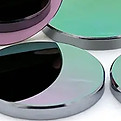
Germanium - Ge
Germanium (Ge) is a dense, high-refractive-index infrared optical material widely used in thermal imaging, spectroscopy, and laser systems. It provides excellent transmission from approximately 2 µm to 14 µm, covering both the mid-wave (MWIR) and long-wave (LWIR) infrared regions. With its high refractive index (~4.0 @ 10 µm), low chromatic dispersion, and outstanding optical uniformity, Germanium is ideal for compact, high-precision infrared optics used in imaging, sensing, and beam control applications.
Unlike materials such as ZnSe or ZnS, Germanium is non-hygroscopic and chemically inert, making it exceptionally stable in humid or outdoor environments. It also exhibits high mechanical strength and thermal stability, although its transmission decreases above ~100 °C due to increased absorption. These characteristics make it a preferred material for infrared windows, lenses, prisms, beam splitters, and domes in defense, industrial, and scientific optical systems.
At Global Optics UK, we supply precision-polished Germanium windows, lenses, prisms, and custom infrared optics, manufactured to strict optical and dimensional tolerances. Components are available with AR or DLC coatings optimized for the 3–5 µm and 8–12 µm spectral bands, ensuring durability and performance in demanding thermal imaging, CO₂ laser, aerospace, and metrology applications.
Explore Related Optical Materials:
Gallium Arsenide (GaAs)
Zinc Selenide (ZnSe)
Zinc Sulphide (ZnS)
FAQ
FAQ
Q: What is Germanium used for?
A: Germanium (Ge) is extensively used in thermal imaging, infrared optics, and spectroscopy. It is ideal for infrared windows, lenses, and prisms operating in the 2–14 µm range, where it provides excellent transmission and minimal chromatic aberration. Germanium is also widely used in CO₂ laser systems, defense and surveillance sensors, and as a semiconductor material in detectors and transistors. Its high refractive index allows for compact, high-performance IR optical designs.
Q: What is the transmission range of Germanium?
A: Germanium transmits efficiently from approximately 2 µm to 14 µm, covering the MWIR and LWIR regions. It is opaque in the visible spectrum and blocks UV light, making it ideal for dedicated infrared applications such as thermal cameras, spectroscopy, and CO₂ laser optics.
Q: Is Germanium mechanically durable?
A: Yes — Germanium is a hard, dense, and stable material with a Knoop hardness of around 780 kg/mm². However, like many crystalline materials, it is brittle and should be handled carefully to avoid chipping or cracking during fabrication and mounting.
Q: Is Germanium hygroscopic?
A: No — Germanium is non-hygroscopic and chemically inert. It is unaffected by moisture and most environmental conditions, making it suitable for rugged applications in aerospace, defense, and outdoor infrared systems.
Q: Where can I download the datasheet?
A: You can download the Germanium (Ge) technical datasheet here


